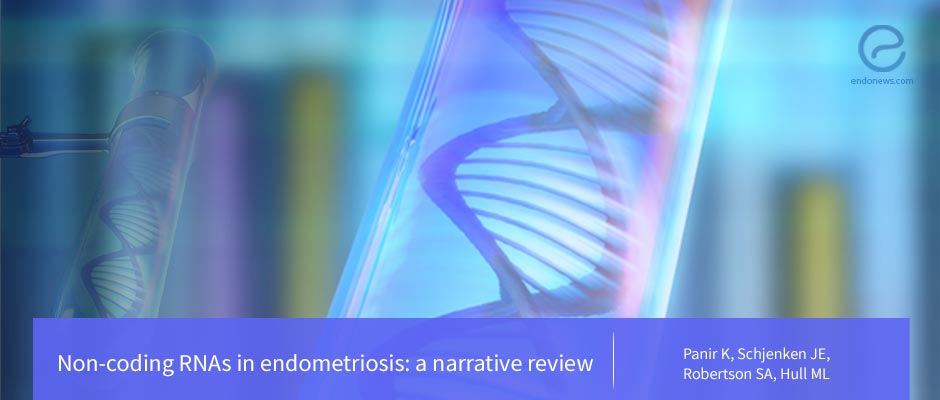Non-coding RNAs in endometriosis
May 28, 2018
Can we use non-coding RNAs as therapeutic targets in endometriosis?
Key Points
Highlight:
- The non-coding RNAs(ncRNAs) have the potential to influence endometriosis development and persistence through modulating inflammation, proliferation, angiogenesis and tissue remodeling.
Goal:
- Dr. Panir group from Women’s and Children’s Hospital Adelaide in Australia summarized the various ncRNAs (miRNAs, lncRNAs, siRNAs) roles in the establishment and progression of endometriosis.
Key points:
- In endometriosis, transcriptome profiling of tissue samples and functional in-vivo and in vitro studies demonstrate that ncRNAs (miRNAs, lncRNAs, siRNAs) are key contributors to the disease process.
- MicroRNAs (miRNAs)
- are a highly conserved family of 19–22nt sequences that regulate post-transcriptional gene expression.
- Multiple studies have shown that miRNA expression is altered in the eutopic endometrium in women with endometriosis compared to healthy women.
- The miRNAs affect a range of cellular and biological pathways which are implicated in endometriotic lesion development including cell proliferation, invasion, inflammation, and angiogenesis.
- Long non-coding RNAs (lncRNAs)
- Most RNAs within the non-coding transcriptome are lncRNAs, and several of them suggested as biomarkers of endometriosis.
- The H19/Let-7/IGF1R regulatory pathway is the first to link a dysregulation in lncRNA to miRNA activity in endometriosis.
- Short interfering RNAs (siRNAs)
- siRNAs are ~22nt long molecules cleaved in the cytoplasm from long double-stranded (ds) RNA by the RNase-III enzyme Dicer.
- Synthetic siRNAs are a potent tool for silencing expression of specific genes.
- This methodology has progressively advanced our knowledge of genes contributing to the endometriotic disease process.
- Identification and experimental manipulation of ncRNAs have widened our understanding of endometriosis, providing a rationale for exploring the potential of ncRNAs as biomarkers and therapeutic agents.
Limitation:
- Large and well-curated cohorts with well-defined clinical data are required to have a better understanding of endometriosis-specific ncRNAs.
Lay Summary
The pathophysiological mechanisms causing the development of endometriosis, which is a heterogeneous disease remain enigmatic, and a lack of effective biomarkers necessitates surgical intervention for diagnosis. Non-coding RNA (ncRNA) molecules, which are important regulators of cellular function, have been implicated in many chronic conditions. In endometriosis, transcriptome profiling of tissue samples and functional in-vivo and in vitro studies demonstrate that ncRNAs are key contributors to the disease process. In this review, Dr. Panir group from Women’s and Children’s Hospital Adelaide in Australia summarized the various ncRNAs (miRNAs, lncRNAs, siRNAs) roles in the establishment and progression of endometriosis.
MicroRNAs (miRNAs) are a highly conserved family of 19–22nt sequences that regulate post-transcriptional gene expression. Multiple studies have shown that miRNA expression is altered in the eutopic endometrium in women with endometriosis compared to healthy women. The miRNAs affect a range of cellular and biological pathways which are implicated in endometriotic lesion development including cell proliferation, invasion, inflammation, and angiogenesis.
Most RNAs within the non-coding transcriptome are long non-coding RNAs (lncRNAs). Several lncRNAs have suggested biomarkers of endometriosis. The H19/Let-7/IGF1R regulatory pathway is the first to link a dysregulation in lncRNA to miRNA activity in endometriosis.
Short interfering RNAs (siRNAs) are ~22nt long molecules cleaved in the cytoplasm from long double-stranded (ds) RNA by the RNase-III enzyme Dicer. Synthetic siRNAs are a potent tool for silencing expression of specific genes. This methodology has progressively advanced our knowledge of genes contributing to the endometriotic disease process. Identification and experimental manipulation of ncRNAs have widened our understanding of endometriosis, providing a rationale for exploring the potential of ncRNAs as biomarkers and therapeutic agents.
There is a compelling case that microRNAs, long non-coding RNAs, and short inhibitory RNAs have the potential to influence endometriosis development and persistence through modulating inflammation, proliferation, angiogenesis and tissue remodeling. Rapid advances in ncRNA biomarker discovery and therapeutics relevant to endometriosis are emerging. However, to have a better understanding in endometriosis-specific ncRNAs, large and well-curated cohorts with well-defined clinical data are highly required.
Research Source: https://www.ncbi.nlm.nih.gov/pubmed/29697794
Endometriosis reproductive disorders non-coding RNA microRNA short interfering RNA long non-coding RNA biomarkers inflammation ectopic endometrial tissue endometrium

